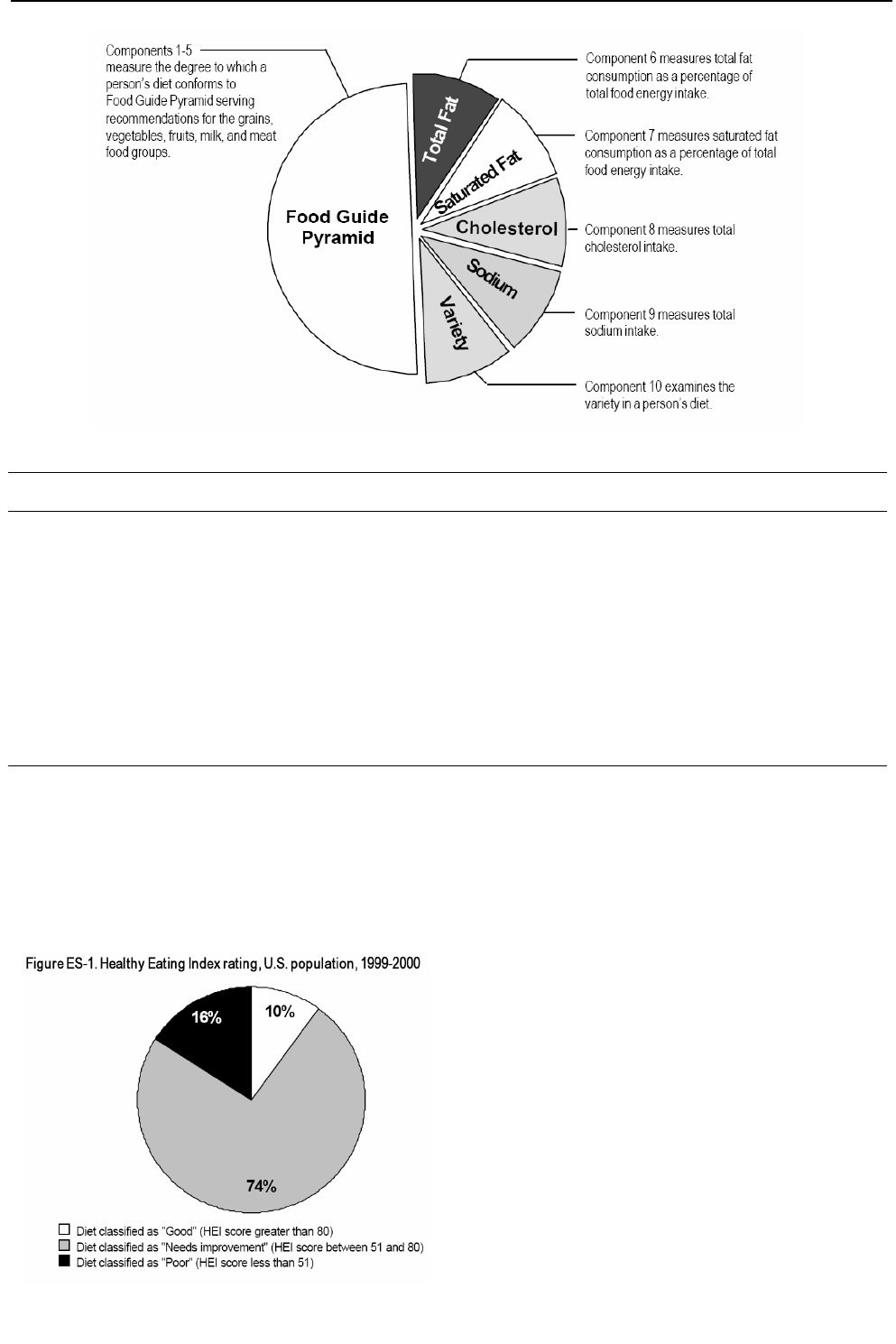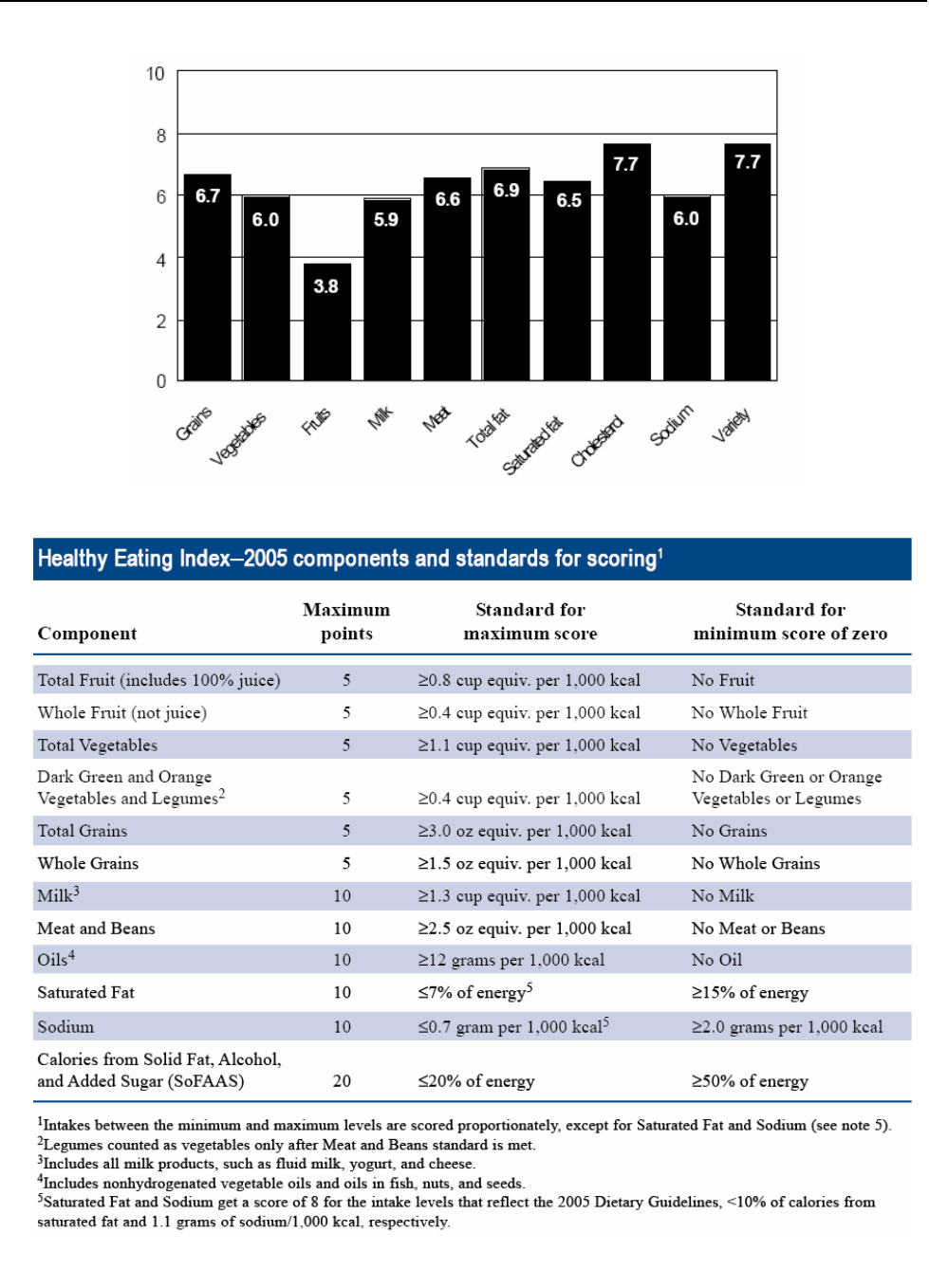
70 Asia Pac J Clin Nutr 2008;17 (S1):70-74
Review Article
Putting the pyramid into action: the Healthy Eating
Index and Food Quality Score
Eileen Kennedy DSc RD
Dean, Friedman School of Nutrition Science and Policy, Tufts University, Boston, MA
Consumption patterns are changing globally. As a result both researchers and policy makers require simple,
easy to use measures of diet quality. The Healthy Eating Index (HEI) was developed as a single, summary
measure of diet quality. The original HEI was a ten component index based on the US Dietary Guidelines and
the Food Guide Pyramid. Research on the HEI indicates that the index correlates significantly with the RDA’s
for a range of nutrients and with an individual’s self-rating of their diet. The revised HEI provides a more dis-
aggregated version of the original index based on the 2005 Dietary Guidelines for Americans. Within each of
the five major food groups, some foods are more nutrient dense than others. Nutrient Density algorithms have
been developed to rate foods within food groups. The selection of the most nutrient dense foods within food
groups lead to a dietary pattern with a higher HEI. The implications of using the HEI and nutrient density to
develop interventions are discussed in this presentation.
Key Words: Diet Quality, Nutrient Density, HEI
INTRODUCTION
More and more countries worldwide have developed or are
developing national food based dietary guidelines. A recent
report indicates that there is remarkable similarities in the
food based guidelines that have emerged, most noticeably
the emphasis on whole grains, fruits and vegetables.
1
In
addition to the emergence of dietary guidelines, there has
also been a call in the research and policy communities to
develop simple indicators to measure diet quality. This
paper discusses the development and use of the Healthy
Eating Index, a single, summary measure of diet quality. In
addition, a food quality score used to rate the nutrient
density of individual foods is presented.
Healthy Eating Index
The Healthy Eating Index (HEI) was developed in the mid-
1990’s to provide a single, summary measure of overall
dietary quality.
2
The HEI was intended to provide a way to
evaluate diet quality at a given point in time, as well as
method for monitoring changes in the food patterns over
time.
The HEI is a ten component index (see Fig. 1). The first
five components of the index are based on the five major
food groups of the 1992 USDA Food Guide Pyramid –
grains, fruits, vegetables, meat and alternates and milk.
3
Components six to ten are based are aspects of the 1995
Dietary Guidelines for Americans
4
including total fat,
saturated fat, cholesterol, sodium and variety. Each of the
ten components ranges in score from zero to ten.
The criteria for scoring each of these ten components is
provided in figure 2. Thus the composite HEI score can
potentially range from a minimum of zero to a maximum
score to 100.
Figure 3 provides an illustration of the distribution of the
HEI scores for a representative sample of the U.S. popula-
tion in 1999-2000.
5
The major portion of the sample has an
average HEI in the range of 51 to 80 and category that is
defined as “needs improvement”. Only 10% of the popula-
tion has an HEI that is characterized as “good” with a HEI
above 80; similarly 16% of the population has an HEI
described as “poor”, falling in the range of 50 or less.
The mean scores for each of the ten components are
shown in figure 4.
5
By far, the lowest score – 3.8 – is
found for the fruits group. Scores for other HEI compo-
nents range from 5.9 to 7.7. The average total HEI tends to
fall in the range of 62 to 64 and there is little variation in
the population over time in the HEI.
6
This last statistic
appears to indicate that on a population level it is difficult
to improve the HEI in a short period of time.
Data from a representative sample for the period 1994-
1996, were used to validate the HEI. The HEI correlated
positively, significantly with a range of nutrient intakes.
2
In addition, the HEI was linked to an individual’s self
perception of their diet. Thus a person who self rated their
diet as poor or fair, were more likely to have a low HEI
than were individuals who rated their diets as good to
excellent.
2
Finally, a person’s HEI correlated with an individual’s
Body Mass Index (BMI) computed from self reported
Corresponding Author: Dr. Eileen Kennedy, Dean, Friedman
School of Nutrition Science and Policy, Tufts University, Boston,
MA
Tel: 617 636 3702; Fax: 617 636 3794
Email: Eileen.kenned[email protected]
Manuscript received 9 September 2007. Accepted 3 December 2007.

E Kennedy 71
Figure 1. Components of the HEI
Score range
1
Criteria for maximum score of 10 Criteria for minimum score of 0
Grain consumption
0 to 10
6-11 servings
2
0 servings
Vegetable consumption 0 to 10 3-5 servings
2
0 servings
Fruit consumption 0 to 10 2-4 servings
2
0 servings
Milk consumption 0 to 10 2-3 servings
2
0 servings
Meat consumption 0 to 10 2-3 servings
2
0 servings
Total fat intake 0 to 10 30% or less energy from fat 45% or more energy from fat
Saturated fat intake 0 to 10 Less than 10% energy from saturated
fat
15% or more energy from saturated fat
Cholesterol intake 0 to 10 300 mg or less 450 mg or more
Sodium intake 0 to 10 2400 mg or less 4800 mg or more
Variety 0 to 10 8 or more different items in a day 3 or fewer different items in a day
1
People with consumption or intakes between the maximum and minimum ranges or amounts were assigned scores proportionately.
2
Number of servings depends on Recommended Energy Allowance-see table 2. All amounts are on a per-day basis.
Figure 2. HEI Component Mean Scores
height and weight.
2
It was always the intention that the HEI would be up-
dated as newer science became available. Thus after the
release of the 2005 Dietary Guidelines for Americans
7
,
the HEI was revised. Figure five presents the updated
components of the HEI included the scoring system
used.
8
The major changes in the 2005 HEI include: an
emphasis on 50% of the fruit category coming from
whole fruit; an separate emphasis on orange and dark
green vegetables as well as legumes; a specification that
50% of the items from the grains category should be
whole grains; a separate category for discretionary calo-
ries from solid fats, alcohol and added sugars.
Nutrient Density Revisited
The 2005 Dietary Guidelines for Americans
7
refer to the
concept of nutrient density throughout the report. While
the concept of nutrient density is not new, these latest
Dietary Guidelines put a renewed emphasis to a scientific
approach that was developed more than 30 years ago.
8
Statements such as
7
:
“Get the most nutrients out of your calories”
Figure 3. Overall HEI Score

72 Diet Quality
And
“Make smart food choices for every food group”
Reinforce the concept of nutrient density.
However, nutrient density is not an idea that is easily
understood by the consumer. In order to provide a
method that would allow consumers to rate the nutritional
quality of individual foods, a food quality score (FQS)
was devised.
9
Similar to the development of the HEI, the
food quality score was based on guidance provided by the
2005 Dietary Guidelines. The Food Quality Score .
9
is
based on two groups of nutrients. First a category called
shortfall nutrients was identified in the 2005 Dietary
Guidelines. Shortfall nutrients are those consumed in in-
sufficient quantities in the U.S. population and include
Figure 4. Mean for 1999-2000 – 63.8
Figure 5. HEI 2005

E Kennedy 73
fiber, Vitamins A, B12, E, C, D, folate, calcium, magne-
sium, iron and potassium. The second category is called
avoidance nutrients and as the name implies are ones
which, on average, need to be reduced in the American
diet. Avoidance nutrients include calories, saturated fats,
cholesterol, sodium and Trans fats.
A series of Food Quality Scores (FQS) were developed.
The Universal FQS (FQS1) applies one algorithm to all
foods using the ratio of shortfall nutrients to avoidance
nutrients. A second FQS was developed using algorithms
that were specialized to specific food group. The 2005
Dietary Guidelines were clear that foods from each of the
food groups were needed since each group provided
foods that were good and excellent sources of different
nutrients. Finally an algorithm with an expanded group
of 23 nutrients was developed.
Data from the USDA SR18 nutrient data base were
used to compute and compare the three different FQS.
Some points are worth noting. Nutrients added through
fortification were treated identically to nutrients naturally
occurring in foods. Mixed dishes composed of items
from more than one food group were decomposed into
their component food groups. For example, lasagna was
assigned proportionate parts to the grains, milk, meat and
vegetable groups for analysis of the food group specific
FQS.
Tables 1 through 3 illustrate the FQS using the three
alternative approaches. While the absolute FQS varies
with the method, the ranking of items within food groups
does not vary. Thus for example, on all three scores dry,
ice cream has the lowest ranking on the items in the dairy
group.
Table 4 illustrates the average universal FQS for the
five food groups. The FQS for fruits and vegetables, not
surprisingly, is substantially higher than for the other
three food groups.
CONCLUSIONS AND RECOMMENDATIONS
The Healthy Eating Index has been used effectively for
monitoring, evaluation and has been adapted to a more
consumer friendly version.
10
Putting the concept of nutri-
ent density into practice is more of challenge. Further
research needs to be conducted to ascertain the effect of
Food Quality Scores, or indeed any food rating system,
on consumer food choices. Researchers have long known
that the major determinants of food choice are taste, price,
and convenience.
11
Whether promotion of a specific food
rating system will significantly influence food choices
and food consumption needs to be empirically determined.
A Food Quality System based on nutrient density can be
one tool that can facilitate more healthful food purchases
and dietary patterns.
ACKNOWLEDGEMENTS
Support for this work was provided by the Friedman School of
Nutrition Science and Policy, Tufts University.
AUTHOR DISCLOSURES
Eileen Kennedy, no conflicts of interest.
Table 1. Dairy
Food Quality Score
Description
FQS
1
Universal FQS
2
Separate FQS
3
Expanded
Milk, dry, whole 3.25% milk fat
0.96 1.60 0.94
Milk, nonfat, fluid, with added vitamin A (fat free or skim)
4.30 7.62 4.30
Ice creams, vanilla
0.39 0.61 0.38
Table 2. Grains
Food Quality Score
Description FQS
1
Universal FQS
2
Separate FQS
3
Expanded
Bread, white, commercially prepared 0.98 1.11 1.34
Cake, angel food, commercially 0.62 0.59 0.71
Cereals ready-to-eat, GENERAL MILIS, TOTAL Corn Flakes 6.02 5.48 5.95
Table 3. Fruits
Food Quality Score
Description FQS
1
Universal FQS
2
Separate FQS
3
Expanded
Apples, raw, with skin 4.18 5.46 3.19
Oranges, raw, all commercial varieties 22.4 30.2 13.3
Table 4. Food Quality Score Averages
Food Group FQS Score average
Fruits 8.09
Vegetables 8.02
Grains 1.89
Dairy 1.24
Meats 1.03
Other 1.21

74 Diet Quality
REFERENCES
1. March of Dimes. Nutrition Today Matters Tomorrow: A
Report from the March of Dimes Task Force on Nutrition
and Optimal Development. March of Dimes: New York,
2001.
2. Kennedy E, Ohls J, Carlson S, K. Fleming. The Health Eat-
ing Index: design and application. J Am Diet Assoc. 1995;
95:1103-8.
3. USDA. Food Guide Pyramid. Government Printing Office:
Washington DC, 1992.
4. Kennedy E, Myers L, Layden W. The 1995 USDA/DHHS
Dietary Guidelines -an overview. J Am Diet Assoc. 1996;
96:234-7.
5. USDA, Center of Nutrition Policy and Promotion. The
Healthy Eating Index: 1999-2000. USDA: Washington, DC,
2002.
6. Basiotis P, Hirshman J, Kennedy E. Economic and socio-
demographic determinants of healthy eating as measured by
USDA’s Healthy Eating Index. Consumer Interests Annual.
1996;42:1-8.
7. USDA/HHS. Dietary Guidelines for Americans. Governing
Printing Office: Washington, DC, 2005.
8. Zelman Kathleen and Kennedy Eileen. March/April 2005.
Naturally Nutrient Rich: Putting More Power on Americans’
Plates. Nutr Today. 40 (2).
9. Kennedy E, Rasca P, Dallal G, Lichtenstein A., Goldberg J,
Wilde P, Gleason G. Food Quality Scores: Nutrient Density
Revisited. Presentation at Experimental Biology Meeting,
San Diego 2006.
10. Kennedy Eileen and Richard Deckelbaum (editors). The
Nations Nutrition. ILSI Press: Washington, DC, 2007.
11. Frazao Elizabeth. America’s Eating Habits: Changes and
Consequences. USDA/ERS: Washington, DC, 1999.
